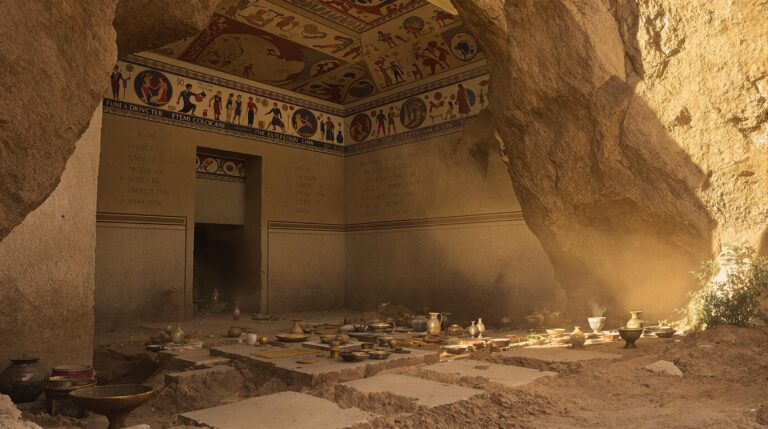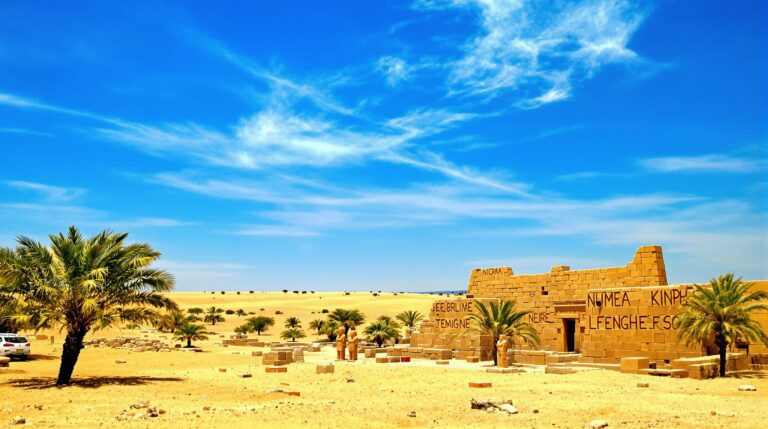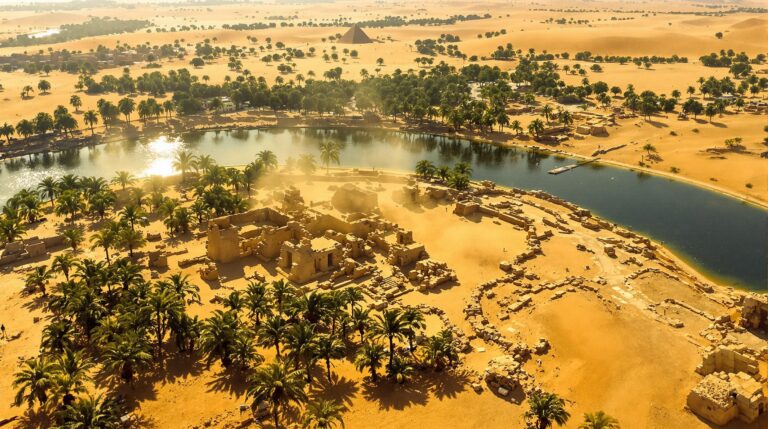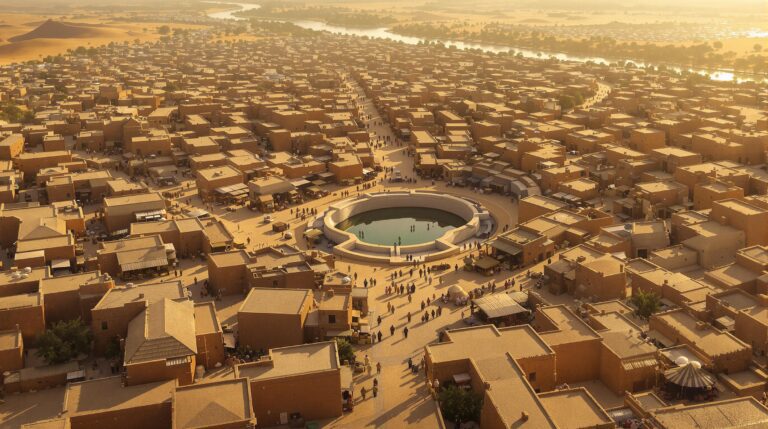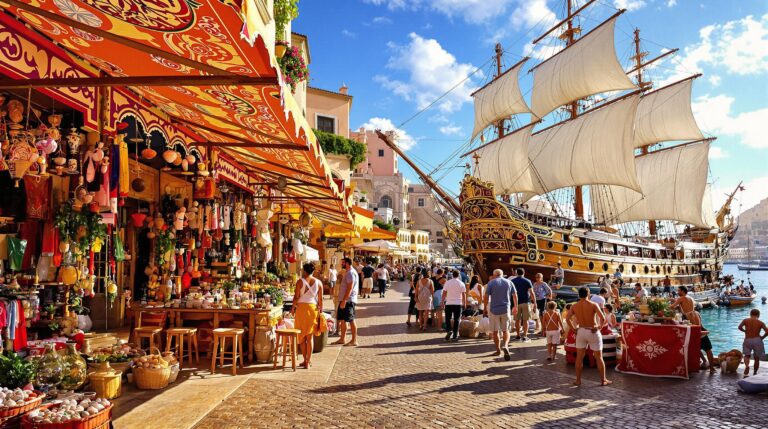Ancient Persia: Golden Age and the Achaemenid Legacy
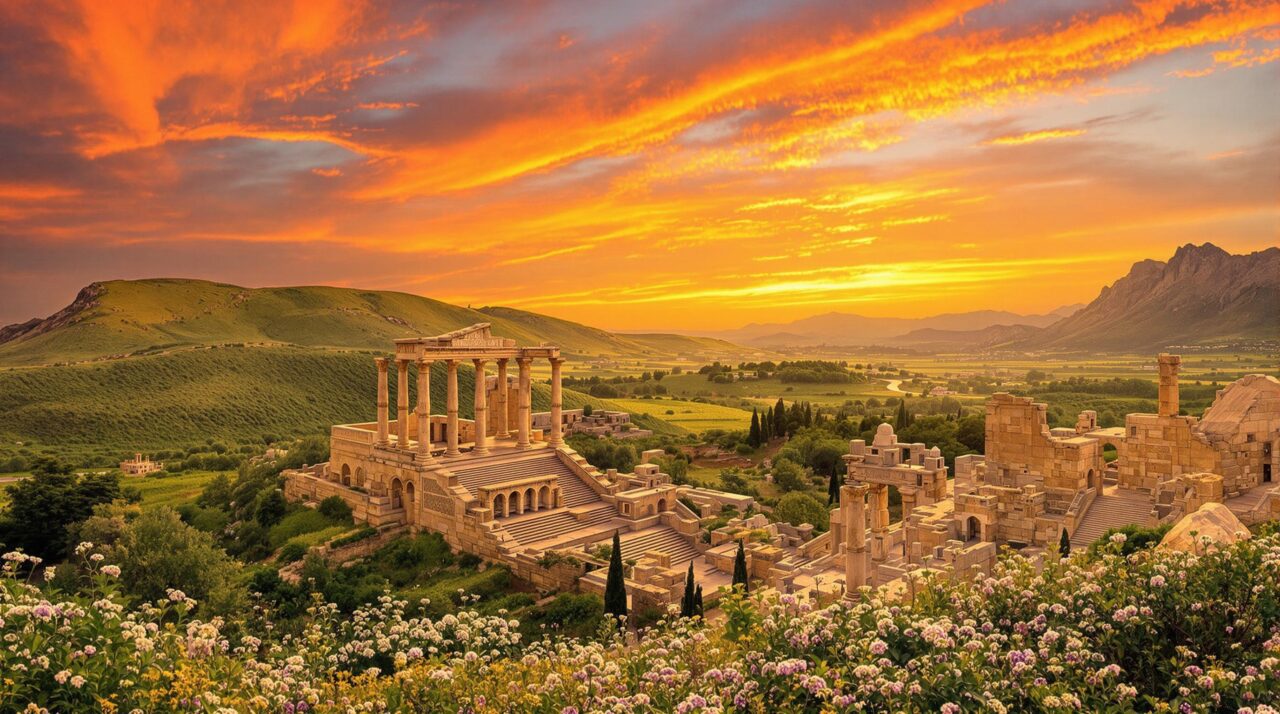
Ancient Persia, often shrouded in the mists of time, presents a tapestry of innovation and culture.
What factors propelled this empire to such heights? The governance of Cyrus the Great and the intricate network of the Royal Road hint at a sophisticated administration.
Yet, beyond mere conquest lies a deeper story of art, religion, and daily life. How did these elements intertwine to shape a legacy that still resonates today?
Principal Conclusions
Hide- The Persian Empire, founded by Cyrus the Great, unified diverse cultures and peoples across the Fertile Crescent, creating a legacy of ambition and ingenuity.
- Innovations like the Royal Road and the Satrap System facilitated swift communication and local governance, enhancing the empire's administration and identity.
- Persian cultural heritage, influenced by Zoroastrianism, shaped daily life through rituals, art, and architecture that reflect harmony with nature.
- Trade routes, including the Silk Road, fostered cultural exchange, enriching Persian art, textiles, and metalwork through interactions with neighboring civilizations.
- The enduring legacy of ancient Persia is visible in monumental architecture and archaeological sites, emphasizing the importance of heritage preservation for future generations.
Origins and Rise of the Persian Empire
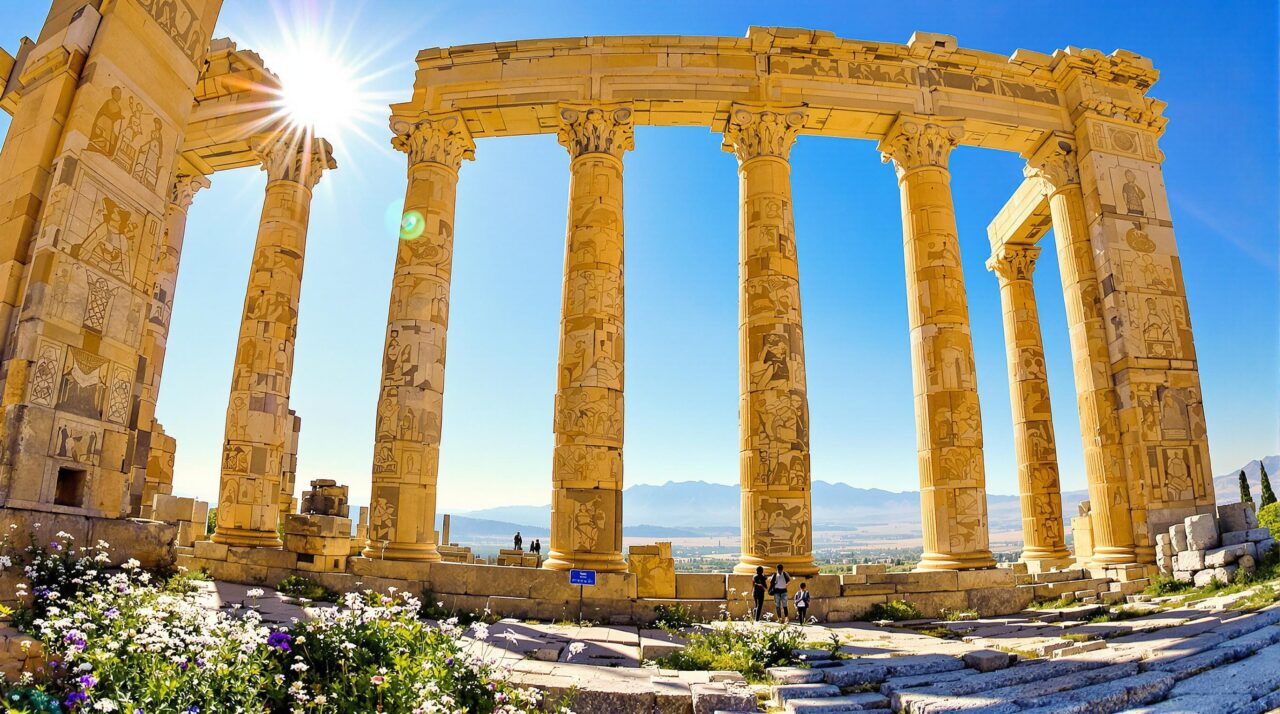
What forces coalesced in the fertile valleys of Persia to give birth to a civilization that would shape the course of history?
The emergence of early settlements and tribal confederations set the stage for the remarkable ascent of Cyrus the Great, whose vision transformed a fragmented landscape into a unified empire.
In this tapestry of ambition and ingenuity, one wonders how such threads intertwined to forge a legacy that endures through the ages.
Early Settlements and Tribal Confederations
In the tapestry of early Persian history, the Medes emerge as a formidable force, weaving their influence into the fabric of the region.
How did the tribal confederations shape the aspirations of Achaemenes, laying the groundwork for the rise of Cyrus the Great?
Unraveling these connections reveals the intricate dance of power and identity that heralded the dawn of an empire.
The Medes and Their Influence on Persia
Throughout history, the Medes have often been overshadowed by their more famous successors, yet their influence on the foundation of Persia is undeniably profound.
As skilled negotiators and fierce warriors, the Medes forged crucial alliances and cultural exchanges. Their governance methods and practices laid essential groundwork, fostering a spirit of unity and ambition that would ultimately shape the Persian Empire‘s destiny.
From Achaemenes to Cyrus the Great
The Medes, with their intricate web of alliances and cultural exchanges, set the stage for the rise of Persia, a journey that began with the legendary Achaemenes.
This early figure, a unifying force amid tribal confederations, sowed the seeds of ambition.
As Achaemenes’s lineage flourished, Cyrus the Great emerged, heralding an era of grandeur, freedom, and expansive horizons for the Persian Empire.
Cyrus the Great and the Foundation of Empire
Cyrus the Great emerges as a pivotal figure, orchestrating conquests that wove together the fragmented tapestry of the Fertile Crescent.
His legacy, enshrined in the Cyrus Cylinder, offers a profound message of tolerance and governance that resonates through the ages.
What alchemy of vision and ambition transformed a tribal leader into the architect of an enduring empire?
Conquests That United the Fertile Crescent
As the sun rose over the sprawling lands of the Fertile Crescent, a remarkable transformation began to unfold under the visionary leadership of a man destined to reshape the ancient world.
Cyrus the Great’s conquests wove together diverse cultures and peoples, forging an unprecedented unity. This synthesis of traditions not only strengthened his empire but also ignited a longing for freedom and shared identity among its inhabitants.
The Cyrus Cylinder and Its Enduring Message
While many artifacts from antiquity tell tales of conquest and power, few resonate as deeply as the Cyrus Cylinder, a profound symbol of governance and human rights.
Its enduring message encompasses:
- The promotion of tolerance.
- The restoration of displaced peoples.
- The affirmation of religious freedom.
- The establishment of just governance.
This ancient decree continues to inspire those who yearn for liberty and dignity.
Expansion and Administration of a Global Power
The reign of Darius I marked a pivotal chapter in Persia’s expansive narrative, as the emperor deftly wove a tapestry of administration that balanced diversity and unity.
How did Xerxes I’s fervent ambitions during the Greco-Persian Wars challenge this intricate structure, pushing the boundaries of power and perseverance?
In this exploration, the complexities of governance and the echoes of conflict reveal the dual nature of a global empire.
The Reign of Darius I and Imperial Organization
Under the reign of Darius I, the vast expanse of the Persian Empire transformed into a tapestry of order and innovation.
How did the Royal Road and the Satrap System interweave with standardized coinage, language, and law to create a cohesive imperial identity?
This era beckons exploration into the mechanisms that not only expanded but also unified a diverse global power.
The Royal Road and the Satrap System
Darius I, a visionary ruler of ancient Persia, orchestrated a monumental transformation in the governance and expansion of his empire.
Central to this endeavor were:
- The Royal Road, facilitating swift communication.
- The Satrap System, ensuring local governance.
- A network of spies, promoting oversight.
- Infrastructure development, enhancing trade routes.
Together, these innovations forged a cohesive domain that embraced diversity while nurturing ambition.
Standardized Coinage, Language, and Law
As the foundations of governance solidified through the Royal Road and the Satrap System, the empire’s expansion required further innovative strategies to unify its vast territories.
Standardized coinage, language, and law emerged as essential threads, weaving together diverse cultures.
These instruments of unity fostered trade, communication, and justice, echoing a vision of order amidst chaos, where freedom could flourish under shared governance.
Xerxes I and the Greco-Persian Wars
In the shadow of Xerxes I, the Greco-Persian Wars unfolded as a tapestry of valor and strategy, woven through the iconic battles of Thermopylae, Salamis, and Plataea.
How did these confrontations not only shape the fate of empires but also redefine cultural narratives across the ancient world?
The echoes of conflict resonate, revealing a complex interplay between ambition and consequence in the annals of history.
Battles of Thermopylae, Salamis, and Plataea
How did the Greco-Persian Wars come to symbolize the clash between East and West? In the battles of Thermopylae, Salamis, and Plataea, pivotal moments unfolded, defining the struggle for ideals.
Key elements include:
- The valor of the Spartan stand.
- Naval ingenuity of the Athenian fleet.
- Tactical brilliance of Persian forces.
- The unyielding spirit of Greek unity.
These events sculpted history’s narrative.
Cultural Consequences of Conflict with Greece
While the Greco-Persian Wars released unprecedented waves of conflict, they also served as a crucible for cultural exchange and transformation within the vast Persian Empire.
The clash ignited a dialogue between civilizations, fostering the dissemination of ideas, art, and philosophy.
This tumultuous period nurtured a diverse mosaic of hybrid identities, questioning the essence of power, unity, and the human spirit in pursuit of freedom.
Architectural and Artistic Achievements
In the grand tapestry of Ancient Persia, the architectural marvel of Persepolis stands as a proof of royal ambition, its stones whispering tales of power and reverence.
Persian gardens, meticulously designed, reveal an intricate understanding of nature’s harmony, reflecting the empire’s engineering prowess and aesthetic sensibilities.
How did these achievements not only shape the landscape but also the very identity of a civilization that thrived amidst wonder?
Persepolis: Royal Symbolism in Stone
Persepolis stands as a monumental tribute to the grandeur of ancient Persia, inviting contemplation of its grand halls adorned with intricate reliefs and inscriptions.
Each stone whispers stories of ceremonial significance, revealing the sophisticated construction techniques that underpinned this architectural marvel.
How do these elements coalesce to embody the royal symbolism that defined an empire?
Grand Halls, Reliefs, and Inscriptions
How does the grandeur of ancient architecture whisper the stories of a civilization?
At Persepolis, the grand halls and intricate reliefs reveal a narrative steeped in symbolism and artistry.
Key elements include:
- Majestic columns that soar towards the heavens.
- Detailed bas-reliefs depicting royal power.
- Inscriptions that celebrate achievements.
- Vast spaces designed for ceremonial gatherings.
Such elements beckon exploration of their deeper meanings.
Ceremonial Function and Construction Techniques
The grand halls of Persepolis served not only as architectural marvels but also as essential centers for ceremonial life, intertwining the spiritual and the political in a masterful display of royal symbolism.
Crafted with precision, their imposing columns and intricate reliefs invite contemplation.
How did these structures embody the aspirations of an empire?
In stone, they whisper tales of power, unity, and reverence.
Persian Gardens and Engineering Mastery
In the heart of ancient Persia, the concept of paradise gardens, or pairidaeza, blossomed as a reflection of nature’s harmony and divine beauty.
Ingenious qanats, weaving beneath the earth, provided sustainable water systems that nurtured these verdant oases, showcasing unparalleled engineering mastery.
How did these elements intertwine to create a landscape that was both an artistic achievement and a confirmation of the civilization’s profound understanding of ecology?
The Concept of Paradise Gardens (Pairidaeza)
While many civilizations have sought to capture the essence of nature within their architectural frameworks, the Persian concept of paradise gardens, or pairidaeza, transcends mere aesthetics, inviting contemplation on the interplay between human ingenuity and the natural world.
These gardens embody:
- Harmonious design
- Symbolic elements
- Innovative irrigation
- Diverse flora
Each aspect reveals a profound connection between culture and the environment, fostering freedom of thought and spirit.
Qanats and Sustainable Water Systems
As one explores the intricate tapestry of ancient Persian engineering, the qanat system emerges as a remarkable feat of ingenuity that illustrates a deep understanding of hydrology and sustainability.
These underground aqueducts, weaving through arid landscapes, not only provided essential water resources but also harmonized with nature, epitomizing a balance between human necessity and environmental stewardship—a true legacy of freedom and ingenuity in the pursuit of life.
Religion, Culture, and Daily Life
In the lively tapestry of Ancient Persia, the threads of Zoroastrianism intertwined with daily rituals and moral values, shaping a society rich in spiritual significance.
Persian clothing, adorned with intricate patterns, reflected not only status but also the cultural narratives woven into the fabric of life, while the aromas of diverse cuisine danced through the air, inviting communal celebrations.
How did these elements coalesce to form a unique identity, one that resonated through the ages and offered a glimpse into the heart of a civilization?
Zoroastrianism and the Moral Order
In the heart of ancient Persia, the teachings of Zoroastrianism illuminate the interplay between the divine and the moral fabric of society.
How did the veneration of Ahura Mazda and the sanctity of fire temples shape daily life, weaving a diverse mosaic of culture and ethics?
In addition, what echoes of this ancient faith resonate within the doctrines of Abrahamic religions and philosophical thought?
Ahura Mazda, Fire Temples, and Sacred Texts
Zoroastrianism, one of the world’s oldest monotheistic faiths, centers around the veneration of Ahura Mazda, the supreme deity embodying wisdom and light.
This faith is enriched by:
- Fire temples, symbols of divine presence.
- Sacred texts like the Avesta, guiding moral conduct.
- Rituals promoting purity and community.
- The duality of good and evil, shaping ethical frameworks.
In this, freedom and responsibility intertwine.
Influence on Abrahamic Faiths and Philosophy
Although often overlooked, the profound impact of Zoroastrianism on the development of Abrahamic faiths reveals a tapestry of shared beliefs and ethical principles that have shaped religious thought and moral frameworks throughout history.
Concepts of duality, judgment, and the eternal struggle between good and evil resonate through Judaism, Christianity, and Islam, inviting contemplation of humanity’s place within a morally ordered cosmos.
Persian Clothing, Cuisine, and Celebrations
In the colorful tapestry of ancient Persia, how did the intricate robes, ornate headgear, and shimmering jewelry of the nobility reflect societal hierarchies and cultural values?
The diverse culinary landscape, rich with spices and flavors, beckons exploration into the roots and significance of Nowruz, a celebration steeped in tradition.
What stories do these elements weave together, illuminating the daily lives and spiritual practices of a civilization that flourished in harmony with nature?
Robes, Headgear, and Jewelry of Nobility
Elegance defined the nobility of ancient Persia, where robes, headgear, and jewelry transcended mere adornment to become symbols of power and identity.
Their attire often featured:
- Silken robes, rich in color.
- Elaborate headdresses, embodying status.
- Intricate jewelry, adorned with gemstones.
- Decorative belts, signifying wealth.
Each element sparked curiosity, inviting contemplation on the interplay of culture, power, and the human spirit.
Dishes, Spices, and the Roots of Nowruz
The opulence of ancient Persia extended beyond the attire of its nobility, weaving through the intricate tapestry of its culinary traditions and celebratory practices.
Dishes adorned with saffron and pomegranate reflected a lively culture, while spices whispered secrets of trade and conquest.
Nowruz, the herald of spring, embodied renewal, uniting flavors and rituals, inviting all to savor the rich heritage of Persian life.
Interactions with Neighboring Civilizations
In the intricate fabric of Ancient Persia, the threads of cultural exchange wove intricately along bustling trade routes, where ideas and goods flowed freely.
What transformations unfolded as Persia encountered the profound legacies of Egypt, the spiritual depths of India, and the intellectual prowess of Babylon?
Each interaction not only shaped the Persian identity but also left an indelible mark on the civilizations that converged at its borders.
Cultural Exchange Along Trade Routes
The trade routes of ancient Persia served as lively arteries of cultural exchange, weaving together diverse civilizations.
Through the Silk Road, artisans shared their craftsmanship, while the fluidity of ideas, styles, and scripts transformed the tapestry of Persian society.
What influences emerged from these interactions, and how did they shape the identities of those who traversed these storied paths?
Silk Road Connections and Artisan Influence
While traversing the vast expanse of the Silk Road, one could not help but marvel at the intricate tapestry of cultures woven together through trade, diplomacy, and artistry.
Artisan influence flourished, manifesting in:
- Unique textiles enriched with lively dyes
- Elaborate ceramics adorned with intricate motifs
- Masterful metalwork reflecting diverse techniques
- Innovative architectural styles inspired by neighboring domains
This exchange birthed a legacy of creativity and collaboration.
The Spread of Ideas, Styles, and Scripts
As cultures intertwined along the bustling trade routes, the exchange of ideas, styles, and scripts became a lively tapestry reflecting the shared experiences of diverse civilizations.
Persian art flourished, blending motifs from Greece and India, while scripts evolved, fostering communication and unity.
This cultural symbiosis not only enriched Persian society but also ignited a flame of creativity across borders, illuminating the essence of human expression.
Encounters with Egypt, India, and Babylon
In the grand tapestry of ancient civilizations, Persia’s encounters with Egypt, India, and Babylon shimmer with the threads of political alliances and religious coexistence.
How did these interactions shape the ethos of a burgeoning empire, fostering a mosaic of multilingual inscriptions and shared rituals?
The echoes of such exchanges invite a closer examination of their profound impact on cultural synthesis and identity within the vast domains of the ancient world.
Political Alliances and Religious Coexistence
Although the vast expanse of ancient Persia often evokes images of grand battles and imperial conquests, the subtler threads of political alliances and religious coexistence weave a more intricate narrative.
Key elements include:
- Strategic marriages enhancing diplomacy.
- Mutual respect for diverse beliefs.
- Trade fostering cultural exchange.
- Collaborative defense against common foes.
Such interactions illustrate a tapestry of unity amid diversity.
Multilingual Inscriptions and Shared Rituals
The lively fabric of ancient Persia was not solely shaped by political maneuvers and alliances; it was also intricately woven with the threads of linguistic diversity and shared cultural practices.
Multilingual inscriptions reveal a tapestry of communication across civilizations, where Persian, Elamite, and Babylonian coexisted.
Rituals transcended borders, echoing the harmonious blend of beliefs, fostering unity in their quest for understanding and enlightenment.
Legacy of the Persian Empire
What remnants of grandeur linger in the shadows of the Persian Empire, once a titan now eclipsed by the brilliance of Alexander?
As the dust settled on its fall, did the echoes of its innovations and philosophies not ripple through the fabric of world history?
In contemplating this legacy, one must ponder how a civilization, though conquered, continues to inspire and shape the contours of human thought and culture.
The Fall Under Alexander the Great
As the flames consumed Persepolis, what remnants of grandeur were lost in the ashes of an empire?
The aftermath of this destruction invites contemplation on the profound Hellenistic influence that permeated the region, reshaping its cultural landscape.
In the shadows of conquest, how did the essence of Persian identity endure, whispering tales of resilience through the annals of history?
The Burning of Persepolis and Aftermath
While the flames consumed the grand hallways of Persepolis, one could not help but ponder the profound implications of this conflagration on the legacy of the Persian Empire.
The aftermath revealed:
- A shattered cultural identity.
- The void of political power.
- An enduring symbol of loss.
- A catalyst for Hellenistic transformation.
In this destruction lay the seeds of both despair and new beginnings.
Hellenistic Influence and Cultural Survival
The flames that engulfed Persepolis did not merely herald the end of a grand empire but also marked the beginning of a profound cultural interchange.
As Alexander’s conquests intertwined Hellenistic ideals with Persian traditions, questions arose: How did these ancient cultures shape one another?
In this crucible of influence, the spirit of Persia endured, whispering tales of resilience amidst the shadows of its past.
Enduring Contributions to World History
What echoes from the annals of the Persian Empire, where governance was an art form and civil rights began to unfurl in the tapestry of human history?
The innovations birthed in this ancient domain resonate through subsequent dynasties and cultures, weaving a legacy that transcends time.
In contemplating these contributions, one may wonder how the ideals of Persian thought continue to shape the world today.
Innovations in Governance and Civil Rights
Countless innovations in governance and civil rights emerged from the vast expanse of the Persian Empire, weaving a legacy that continues to influence modern societies.
These contributions can be identified as:
- Establishment of a bureaucratic system.
- Promotion of religious tolerance.
- Implementation of standardized laws.
- Development of communication networks.
Such advancements invite reflection on freedom, equality, and the potential for a just society.
Persian Thought in Later Dynasties and Cultures
Persian thought, a lively mosaic woven through the ages, has profoundly influenced subsequent dynasties and cultures long after the fall of the Persian Empire.
Its philosophical tenets, intermingling ethics and governance, inspired thinkers from the Islamic Golden Age to the Renaissance.
This intellectual legacy, rich in ideas of justice and harmony, continues to resonate, inviting contemporary societies to explore its enduring wisdom.
Modern Reflections and Preservation
In the shadows of ancient ruins, how do archaeological discoveries illuminate the modern world’s understanding of Persian heritage?
As contemporary culture intertwines with the echoes of this once-mighty empire, one must ponder the delicate balance between preserving the past and embracing the present.
What stories do these heritage sites whisper to a society longing for connection with its historical roots?
Archaeological Discoveries and Heritage Sites
In the shadows of Susa, Pasargadae, and Persepolis, the whispers of ancient civilizations beckon the modern observer to reflect on their stories anew.
How do these archaeological treasures, now safeguarded by UNESCO, reflect not only the grandeur of a bygone era but also the urgent need for preservation in an ever-changing world?
The significance of these sites transcends mere history, inviting contemplation on the delicate balance between heritage and contemporary existence.
Excavations at Susa, Pasargadae, and Persepolis
Countless layers of history unfold at the archaeological sites of Susa, Pasargadae, and Persepolis, each whispering tales of grandeur and innovation from the ancient Persian Empire.
The excavations reveal:
- Monumental architecture reflecting imperial ambition.
- Intricate artifacts illuminating daily life.
- Engravings revealing cultural narratives.
- Urban layouts suggesting advanced governance.
These discoveries invite reflection on heritage and the enduring spirit of human creativity.
UNESCO Protection and National Significance
The archaeological treasures unearthed at Susa, Pasargadae, and Persepolis not only illuminate the grandeur of the ancient Persian Empire but also raise pertinent questions about the ongoing responsibility to preserve such heritage.
UNESCO’s designation of these sites as World Heritage reflects a collective acknowledgment of their significance, urging modern custodians to safeguard the whispers of history that echo through time, inviting future generations to marvel and learn.
Ancient Persia in Contemporary Culture
In the tapestry of contemporary culture, Ancient Persia weaves its lively threads through literature, film, and the collective identity of nations.
How do festivals and reenactments breathe life into the echoes of a once-mighty empire, inviting individuals to connect with a storied past?
As historical interest flourishes, one must ponder the delicate balance between honoring heritage and shaping modern narratives.
Influence in Literature, Film, and Identity
While the echoes of Ancient Persia resonate through the ages, their influence on modern literature, film, and cultural identity invites a rich exploration.
This legacy manifests in various forms:
- Literary Inspirations: Epic tales and poetic motifs.
- Cinematic Narratives: Visually stunning interpretations.
- Cultural Identity: A bridge between past and present.
- Symbolic Art: Motifs reflecting ancient ethos.
Such reflections inspire a quest for understanding and connection.
Festivals, Reenactments, and Historical Interest
As communities seek to reconnect with their heritage, festivals and reenactments serve as lively conduits for the intricate fabric of Ancient Persia’s legacy.
These colorful gatherings invite participants to immerse themselves in age-old traditions, igniting curiosity and appreciation.
Through the lens of performance, history breathes anew, prompting reflections on identity, cultural resilience, and the enduring whispers of a civilization that once flourished.
Wrapping Up
In the tapestry of time, the Persian Empire emerges as a profound paradigm of progress and pluralism.
Its architectural artistry and cultural confluence continue to captivate contemporary curiosity.
As echoes of antiquity intertwine with modern musings, one wonders: can the wisdom woven into the fabric of this ancient civilization guide today’s global society?
The legacy of Persia persists, prompting persistent reflection on the power of unity, diversity, and enduring human spirit that transcends temporal boundaries.
